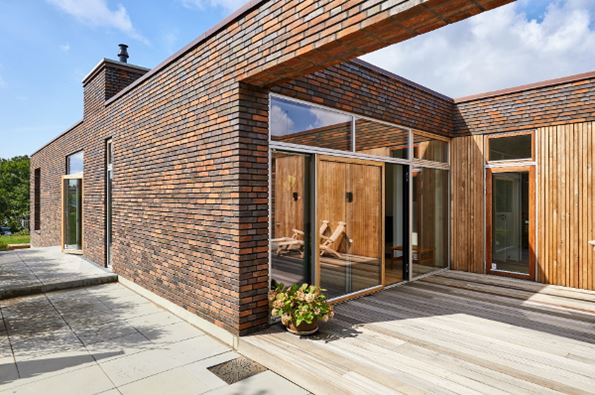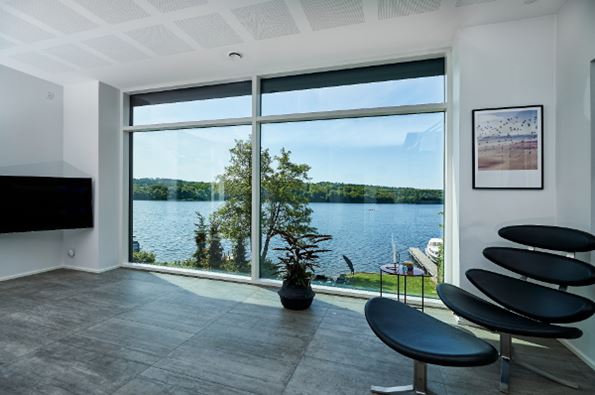Think long term when it comes to renovation
Replacing 15 to 20-year-old windows makes it possible to reduce the house’s heat loss by about 30%. This reduces the heating bills and gives a family a bit more spending power.
Energy-enhancing solutions are not free, but bear in mind that the cost of new windows is a one-off expense, which should be regarded as an investment that will soon pay for itself.
Example: 20 to 25-year-old windows have a UW-value of about 2,5. New KASTRUP ENERGY triple glazed windows have a UW-value of 0,78. Let’s assume a home has a 50-m2 window surface and heating costs of around 14 pence per kWh. Consequently, with Kastrup windows you will save more than £800 on heating per year.
However, reducing regular heating costs is not the only reason to renovate. Other good reasons include:
- Increasing your quality of life, since the house has healthier indoor climate and provides better comfort.
- Refurbishing your home with large, modern glass windows that provide more light without the need to build from scratch.
- Increasing the sales value of your house if you switch to the latest technology in the areas of home security and functionality.
- Making your home more aesthetically pleasing, while eliminating worn wood and cracks in the paintwork.
Kastrup’s windows and doors enable you to refurbish with respect for the architecture, while also reaping all the benefits. We offer:
- A wide range of products with high insulating energy values.
- The design style CLASSIC that preserves and enhances the traditional soul of the house.
- Slim profiles and sliding doors with large glass surfaces that provide more daylight inside the house.
- Windows that are certified and tested for the security and noise requirements of tomorrow.
- The choice between different types of sun-protection glass, soundproof glass and safety glass, depending on your wishes.

Sustainable new build
Right now, the trend is energy-efficient housing, and the demands for this are greatly increasing.
That does not only mean building in an energy-efficient way. It also means that you need to create value in the home that will last for several years. This is why Kastrup develops its products with an eye for durability, longevity and the technological challenges of tomorrow.
New build gives you the freedom to design everything exactly as you want. We are seeing larger areas of glass in new, modern houses. Kastrup’s most slender window series KASTRUP ENERGY, which is perfect for this type of new build, our AluFrontLine panelled door with wood on the interiors and aluminium on the exterior, and our sliding doors enable you to create a modern, high-quality home.
Our timeless wood/aluminium KASTRUP ENERGY series with its numerous architectural features accommodates the needs of homeowners who expect energy saving, security and comfort in their new homes.
Modern windows ensure that rooms get the greatest possible light and thermal insulation, thereby reducing heating costs and improving quality of life. When the sun shines, your windows are your natural source of heating. The right choice of glass is essential when it comes to energy in new build. During the hot summer months, it is important to avoid overheating. In this context, Kastrup can help you with different kinds of solar control glass. Kastrup is also offering the latest glass technology ECLAZ glass, that for instance gives the possibility of enjoying the thermal insulation of triple glazing while ensuring the natural light intake of a double-glazing unit.

Valuable facts for your new windows
UW value in W/m2K = the window’s heat insulation
The lower it is, the less heat loss. The overall UW value of the window is a measure of how well the window insulates. The UW value varies depending on the size and design of the window.
Ug value in W/m2K = the heat insulation of the glass
The lower it is, the less heat loss. The Ug value of the glass is an expression of the insulating ability of the glass measured at the centre of the glass.
G value in % = solar energy transmission
The higher it is, the warmer it is. The G value is that part of the sun’s heat that penetrates the window. If the amount of solar heat outside is 100% and the G value of the window is 0.63, this means that 63% of the sun’s heat penetrates the window.
LT value in % = light transmittance
The higher this is, the lighter it is. The LT value describes the proportion of sunlight that penetrates the glass. If the LT value of the glass is 0.8, it means that 80% of daylight penetrates the glass.
RW value in dB = noise reduction
The higher it is, the greater the silencing effect. RW is an expression of the noise-cancelling effect of the glass. The human ear experiences half the noise with a silencing effect of 8-10 dB.
Double glazing or triple glazing
When you are choosing window glass, consider whether the pane should be constructed as double glazing or triple glazing and what quality it should be.
The cheapest solution is double glazing. One advantage of the two glass panes is that you get more daylight and thus more heat from the sun in your living room. On the other hand, the heat insulation is poorer than with triple glazed windows, and this impacts the heating bill and comfort during the winter.
Triple glazed windows provide better energy savings and no draught from the window surface. There is less natural heat from the sun that penetrates the glass and triple glazing is also about 10% more expensive compared to the cost of a double-glazed window. When fitting new windows in your home, you should regard it as an investment in terms of comfort and reduced heating costs.
Looking at the budget alone, the question is whether the annual savings on the heating bill can justify the extra price you have to pay for having triple glazing.
Example: With 50m2 of window area and heating costs of 14 pence per kWh, you will typically save around 200£ per year if you go for triple glazing rather than double glazing. If the additional cost of triple glazing is around 2000£, that means that the triple glazing has a simple payback time of approximately 10 years.
The above example and the enhanced comfort conclude that Kastrup generally recommend triple glazing as a sensible choice.
There are several issues to take into account when choosing triple glazing. If the house is poorly insulated in general, simply upgrading your windows may result in the heat escaping through poorly insulated walls instead. If your house is well insulated, triple glazed windows are a reasonable investment. The excellent thermal insulation provided by triple glazing also places some demands on the ventilation of the rooms. This can be solved by trickle vents built into the windows. Otherwise, there may be adverse consequences for the indoor climate.
Kastrup is the first supplier in Denmark to offer the new ECLAZ glass as standard for double glazed windows and doors. ECLAZ is the latest glass technology, providing 4% more natural light in your home. An Ug value of 0.53 gives you up to 19% better insulation performance on the glass than in the case of ordinary glass. There is always the additional option of ECLAZ glass for our triple glazed windows and doors.
The spacer between the panes are thermally the weakest part of the glass. Aluminium spacers have a negative effect on heat insulation. With Swisspacer Advance, Kastrup uses an optimal spacer made of tempered plastic and stainless steel, which increase the insulation properties of the window. Between the cavities in the glass, Kastrup uses argon gas. It is completely transparent and harmless and has an additional insulating effect because the gas conducts heat less than air.
Kastrup uses energy panes as standard for triple glazing. These panes have an energy coating that reflects heat radiation, thereby reducing heat loss. Kastrup offers different types of triple glazing with Ug values as little as 0.4. Our standard triple glazed glass has an Ug value of less than 0.5.
Kastrup also offers special solar control glass, which prevents part of the sunlight from penetrating the glass, thus stopping the heat as well. Solar control glass is the result of staining the glass or giving it a surface treatment, so the glass tints the view.

